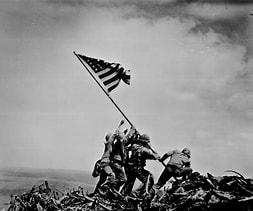(Click on the Picture on the left to see the whole article)
BRIEF HISTORY OF THE
AMERICAN LEGION
III. Veterans’ Affairs and Rehabilitation
The Founders of The American Legion, when they met at the St. Louis caucus, recognized that a major concern of the organization would be the plight of the disabled veteran. The extent of the concern for these men is evident in the final phrase of the Preamble, “to consecrate and sanctify our comradeship by our devotion to mutual helpfulness.”
The D’Olier administration completed the organization of the National Service Bureau, which worked with the state service bureaus and service officers of individual posts to assist veterans with problems of war risk insurance, compensation for disabilities, hospital treatment, and vocational training. The American Legion received financial assistance in this phase for the program from the American Red Cross. Immediately after the close of the 1920 convention in Cleveland, Ohio, National Commander Frederick W, Galbraith, Jr., called a conference in Washington, D.C., to consider the plight of disabled veterans resulting from an unwieldy mass of laws and regulations administered by several different government bureaus. Out of that conference came The American Legion’s request for a Presidential committee to investigate existing conditions. As a result, the Dawes Committee, which included representatives of The American Legion, was appointed. The Dawes Committee report, accompanied by White House recommendations, brought about Congressional action consolidating most of the activities dealing with World War I veterans into a new independent agency- The United States Veterans Bureau (now the Veterans Administration).
The Veterans Bureau continued under careful study by The American Legion during the next two years, and many reforms were suggested by Legion leadership and put into effect, eliminating abuses that deprived veterans of hospital treatment and other rights authorized by Congress. It was in the same period that The American Legion improved its own procedures of handling veterans’ matters by organizing the National Rehabilitation Committee to promote better administration of this important and highly complex activity. The National Rehabilitation Committee later became the National Rehabilitation Commission and , as a result of action taken by the 1970 National Convention, it was renamed the National Veterans Affairs and Rehabilitation Commission.
Justice for the disabled veterans was now The American Legion’s fight in earnest. In 1923, the San Francisco Convention drafted 91 constructive recommendations for liberalization of laws and regulations governing veterans’ benefits. Before the next National Convention was to gather, Congress had enacted the World War Veterans Act of 1924, which included many of The American Legion’s proposals and extended the presumption of service connection for certain classes of disability.
Throughout the remainder of the 1920s and early into the 1930s, The American Legion continued to register legislative achievements necessary for the care and rehabilitation of disabled veterans.


Comments